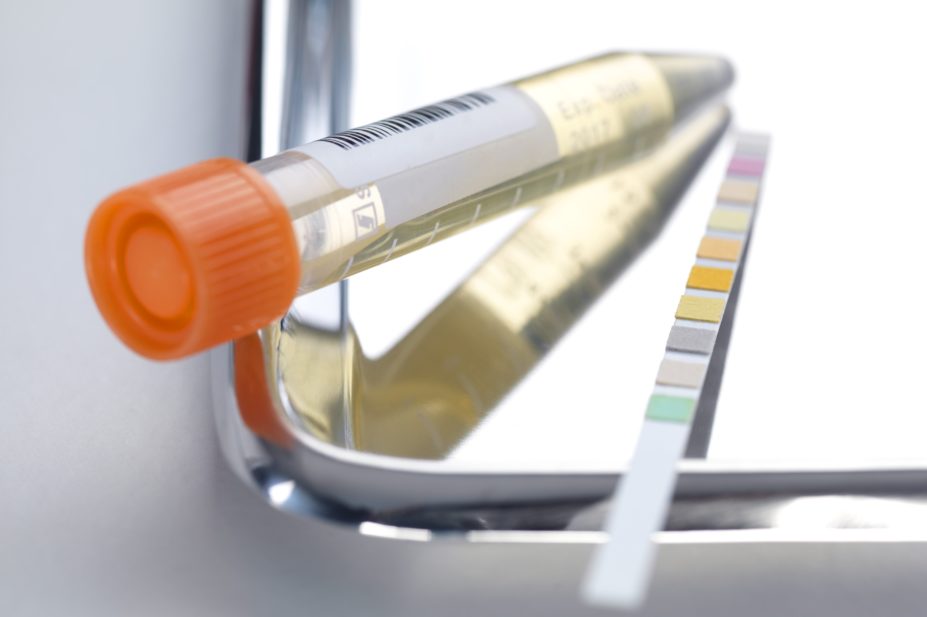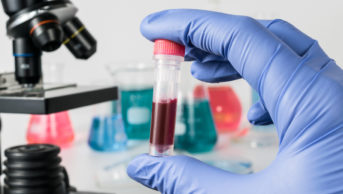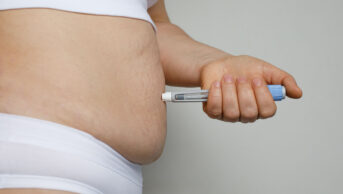
Science Photo Library
Urinary tract infections (UTIs) are among the world’s most prolific infections, but there are concerns that the current approach to diagnosing and managing them is both outdated and inaccurate.
Dipstick testing — the most common and simple diagnostic test for uncomplicated UTI — helps detect nitrites, chemicals created by the presence of gram-negative bacteria in the urine; leukocytes, which are white blood cells produced to fight infection; and red blood cells[1]
.
However, studies have shown that a negative dipstick test in the presence of a strongly suggestive history of UTI cannot reliably rule out an infection and guidelines on their use vary across the UK[2]
.
There are also doubts concerning another diagnostic test — mid-stream urine culture — that is usually reserved for complicated infections or suspected UTIs in men. Urology experts say that there is a “recognised weakness” in conventional urine culture testing, owing to the fact that the threshold for determining the presence of a UTI is based on outdated research from the 1950s.
Most other infections have now moved onto more sophisticated forms of testing, but this hasn’t become prevalent for UTIs because of the cost and sheer volume of UTI tests carried out
“UTI testing is out of date,” says Ased Ali, a consultant urologist at Mid Yorkshire Hospitals NHS Trust and a member of the British Association of Urological Surgeons (BAUS).
“Most other infections have now moved onto more sophisticated forms of testing, [but] this hasn’t become prevalent for UTIs because of the cost and sheer volume of UTI tests carried out.
“A mass change to molecular testing, for example, would be too expensive,” he explains.
With antimicrobial stewardship a priority for the government, and studies showing that up to 50% of women who present to their GP with the symptoms of a UTI do not actually have one, the importance of nailing down the most effective approach to UTI diagnosis has never been more crucial[3]
.
Out of date criteria
Urine culture testing is based on work carried out in 1957 by the scientist Edward Kass, who gathered urine samples from a small group of pregnant women who had pyelonephritis, meaning his work was not representative of patients with acute cystitis.
The subsequent microbiological threshold that was developed based on Kass’ work, and that is still used to diagnose UTIs, looks for the presence of at least 100,000 colony-forming units of bacteria per millilitre of urine (CFU/ml) of a single species of a known pathogen to confirm an infection[4]
.
However, studies have demonstrated that this threshold is too high to pick up all infections.
Further work in patients with classic symptoms of acute cystitis has demonstrated that a 100,000 CFU/ml threshold missed nearly 50% of genuine infections[5],[6]
. In such patients, a threshold of 100 CFU/ml of a known urinary pathogen was proposed as more appropriate.
On behalf of BAUS, Ali and consultant urological surgeon Chris Harding told The Pharmaceutical Journal that issues with the accuracy of tests are further compounded by the increasing recognition that the bladder is not ‘sterile’, even in patients without infection.
“Asymptomatic presence of bacteria in [elderly people] is very common (15–30% in elderly men and 25–50% in elderly women), making diagnosis of ‘true’ UTI extremely difficult,” they explain.
At the heart of diagnosis of interstitial cystitis is the fact you have to exclude a UTI, so it is reliant on the accuracy of UTI testing
According to Ali, inaccurate UTI testing can also result in the misdiagnosis of related conditions, such as painful bladder syndrome, or interstitial cystitis (IC), which are both known as ‘diagnoses by exclusion’.
“At the heart of diagnosis of IC is the fact you have to exclude a UTI, so it is reliant on the accuracy of UTI testing,” he explains.
“If your testing is inaccurate then you’ll unintentionally misdiagnose. It’s no surprise that if someone presents with symptoms that sound like a UTI on several occasions, but each time the urine result is negative, they get led down the IC path.”
To dip or not to dip
Urine culture is not routinely recommended, other than in patients with atypical symptoms or those with risk factors, such as older adults, men, pregnant women, patients with anatomical or functional abnormalities of the urinary tract, urinary catheters or renal disease.
The results of these tests can take 24–72 hours to come back, meaning that, in some cases, symptoms may resolve before the result can influence diagnosis or management.
However, there is continuing debate regarding the most appropriate approach when it comes to dipsticks.
A meta-analysis in 2006 showed that the presence of leukocytes on a dipstick was only 72% sensitive and nitrites only 54% sensitive, and even together gave only 81% sensitivity[7]
.
There is consensus that dipsticks are unreliable in adults aged over 65 years, so they are not generally recommended for these patients. But advice varies for those aged under 65 years with no risk factors for complicated infection.
For these women, the National Institute for Health and Care Excellence (NICE) recommends using a dipstick as an “aid” to diagnosis, alongside assessment of clinical signs of a UTI.
Guidance published by Public Health England (PHE) is more specific, advising that dipsticks are only needed to improve diagnostic accuracy in women aged under 65 years who have no symptoms or one of three key symptoms of a UTI: a burning pain when passing urine; passing urine more often than usual at night; or passing urine that is cloudy to the naked eye[1]
. Women in this age group with two or more symptoms can be treated without dipstick confirmation, according to PHE.
In contrast, guidance recently published by the Scottish Intercollegiate Guidelines Network (SIGN)— the organisation that produces clinical guidelines for the NHS in Scotland — says that accurate diagnosis of a lower UTI in women aged under 65 years should be based on a positive dipstick test result for nitrite, alongside two or more urinary symptoms[8]
. It specifies that dipstick test urine should be retained in the bladder for at least four hours to allow conversion of urinary nitrates to nitrite by pathogens.
When we looked at the evidence for the various contributions of each symptom to how accurate the diagnosis was, we found that adding dipstick testing increased the accuracy
Previously, SIGN advised using dipstick tests to guide treatment decisions in otherwise healthy women aged under 65 years with either mild or no more than two UTI symptoms.
“When we looked at the evidence for the various contributions of each symptom to how accurate the diagnosis was, we found that adding dipstick testing increased the accuracy,” explains Jacqueline Sneddon, chair of the group that developed the guidance.
“It is possible to still empirically treat people on signs and symptoms, but combining symptoms with dipstick [testing] is the best option — and it may prevent unnecessary use of antibiotics,” she adds.
The new guideline states that a positive nitrite dipstick test is helpful to rule in a UTI, although a negative test does not exclude a UTI. It also says that non-steroidal anti-inflammatory drugs, rather than antibiotics, should be considered as a first-line treatment in women with suspected uncomplicated UTI who describe their symptoms as mild, and as an alternative to antibiotics when symptoms are moderate to severe.
Sneddon, who is also chair of the Royal Pharmaceutical Society Antimicrobial Expert Advisory Group, acknowledges that, in the short term, it would be a challenge to implement the recommendations in community pharmacy.
“In community pharmacy practice, it is relatively uncommon for UTI assessment to include use of [dipstick tests], although it has previously been a part of some local services … going forward, we would anticipate that pharmacists could be given the opportunity to receive additional training and support to allow urinalysis to become part of standard practice.”
However, some community pharmacy services have already found ways to routinely use dipsticks to aid UTI diagnosis.
In January 2019, Boots introduced its own private pay, test and treat service (see Box). Patients can buy a Dip UTI test kit for £10 and download an accompanying app that guides them through the process and delivers their results. The patients are then encouraged to visit a Boots pharmacy to discuss their treatment. And, in July 2019, NHS England launched a test-and-treat pilot offering free dipstick UTI home testing kits to women, where needed.
Box: The role of community pharmacy
In Forth Valley, Scotland, a UTI testing service was set up after a successful five-month pilot in 2016, during which 75 pharmacists offered advice, treatment or referral to almost 900 patients experiencing UTI-related symptoms[9]
. The service was rolled out nationally in November 2017.
The success of the service prompted change outside Scotland as well, with Boots introducing its own private pay, test and treat service in 2019. NHS England followed suit later the same year with a test-and-treat pilot in 37 pharmacies across Derbyshire and Nottinghamshire. Similar services in Cornwall and Oxfordshire have also been launched and work is under way to introduce them in the East Midlands region.
In March 2020, an evaluation of the Boots service published in JAC – Antimicrobial Resistance concluded that adding UTIs to minor ailment services provided in community pharmacies could support appropriate use of antibiotics, enabled further by their accessible opening times, convenient locations and no requirement for appointments, as well as reduce demand on GP surgeries[10]
.
Time for change
Accurate diagnosis of UTIs is important because a significant risk of empirical treatment is the emergence of multi-drug-resistant organisms
Accurate diagnosis of UTIs is important because a significant risk of empirical treatment is the emergence of multi-drug-resistant organisms. With UTIs being the second most common diagnosis for which antibiotics are prescribed, rationalising and limiting unnecessary antibiotic use in patients with suspected UTI is a crucial step in controlling antimicrobial resistance (AMR).
Resistance to routinely prescribed antibiotics for UTIs is common, with around a third of Escherichia coli (or coliform) positive urine specimens in the community in England resistant to trimethoprim in 2015.
However, a decrease in resistance to trimethoprim among these bacteria was observed between 2015 and 2020 (see Figure), most likely because of the increased emphasis on nitrofurantoin as first-line treatment for UTIs and the implementation of the Quality Premium in primary care to drive this improvement in antibiotic prescribing[11]
.

Figure: Resistance to key antibiotics among
Escherichia coli
(or coliform) positive urine specimens
Source: Public Health England Fingertips portal
In 2015, a third of Escherichia coli (or coliform) positive urine specimens in the community in England were resistant to trimethoprim. However, an increased emphasis on nitrofurantoin as first-line treatment in recent years has seen resistance to trimethoprim decrease. Resistance to nitrofurantoin has also seen a slight decline.
But experts argue that, longer term, to really make a significant difference to AMR, an overhaul in the way that UTIs are diagnosed and treated is needed.
For Daniel Berman, head of Global Health at Nesta Challenge, which leads the Longitude Prize— a £10m project designed to incentivise the development of a rapid diagnostic test to improve the use of antibiotics — current testing of UTIs is unacceptably “mediocre”.
“[The issue] needs to be treated with more seriousness and urgency,” he says. “[Current testing] is not good enough and it needs to change.”
Some alternatives are getting closer to commercial development. In June 2020, Longitude prize winner Module Innovations, based in India, received US$700,000 of funding from Boston-based CARB-X — a public-private partnership focused on tackling AMR worldwide — for its state-of-the-art diagnostic tools for UTIs.
USense is a small, portable device that “looks very much like a pregnancy test,” says Sachin Dubey, co-founder and chief executive of Module Innovations. “It requires two to three drops of urine and will show what type of pathogen is there, and if it’s a gram-positive or negative organism.” Crucially, it can deliver those results in as little as two to three hours.
A second test, currently in development, will test this sample against a panel of 15 antibiotics and tell you which will be the most effective in just 15 minutes. Used together, “the complete diagnostic time cycle is reduced to just a few hours”, adds Dubey.
We need a test that is both sensitive and specific, affordable and able to integrate into the workflow of GP surgeries, hospitals and pharmacies
“Current methods allow organisms to grow on a medium until they’re visible to the eyes, which takes two to three days,” he explains. “But we’ve created signalling molecules that — with a minimum quantity of the organism — can help them be visibly seen.”
Accuracy of the tests is also 98-99%, he says, with trials having been carried out on around 250 patients. With the recent CARB-X grant, the plan is to expand these trials to 2,000 patients, which Dubey estimates will take up to four months. In as little as six months, he is hoping the product will be available commercially, albeit in India to begin with.
“We need a test that is both sensitive and specific, affordable and able to integrate into the workflow of GP surgeries, hospitals and pharmacies,” says Berman.
“Imagine if the pharmacist had a test that was practical to use and told them which drug would work: that would be a game changer.”
References
[1] Public Health England. 2019. Available at: https://assets.publishing.service.gov.uk/government/uploads/system/uploads/attachment_data/file/829721/Diagnosis_of_urinary_tract_infections_UTI_diagnostic_flowchart.pdf (accessed October 2020)
[2] Mambatta A, Jayarajan J, Rashme V, et al. J Family Med Prim Care 2015 Apr-Jun; 4(2): 265–268. doi: 10.4103/2249-4863.154672
[3] East Midlands Academic Health Science Network. 2020. Available at: https://emahsn.org.uk/images/Digital_UTI_Pathway_Evaluation_-_Final_v270720.pdf (accessed October 2020)
[4] Kass E. November 1957. AMA Arch Intern Med 1957;100(5):709-714. doi:10.1001/archinte.1957.00260110025004
[5] Stamm W, Counts G, Running K et al. N Engl J Med 1982; 307(8): 463-468. doi: 10.1056/NEJM198208193070802
[6] Latham R, Wong E, Larson A, et al. JAMA 1985; 254(23): 3333-3336. PMID: 3906157
[7] St John A, Boyd J, Lowes A et al. Am J Clin Pathol 2006;126(3):428-436. doi: 10.1309/C69RW1BT7E4QAFPV
[8] Scottish Intercollegiate Guidelines Network. September 2020. Available here: https://www.sign.ac.uk/media/1766/sign-160-uti-0-1_web-version.pdf (accessed October 2020)
[9] Stewart F, Caldwell G, Cassells K, et al. Pr Health Care Res & Dev 19;6:531-541. doi: 10.1017/S1463423617000925
[10] Thornley T, Kirkdale C, Beech E et al. JAC-Antimicrobial Resistance 2020. doi: 10.1093/jacamr/dlaa010
[11] Public Health England. 2020. Available at: https://fingertips.phe.org.uk/profile/amr-local-indicators/data#page/4/gid/1938132908/pat/15/par/E92000001/ati/165/are/E38000056/iid/92519/age/1/sex/4/cid/4/tbm/1 (accessed October 2020)


